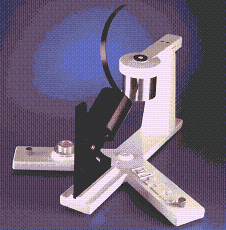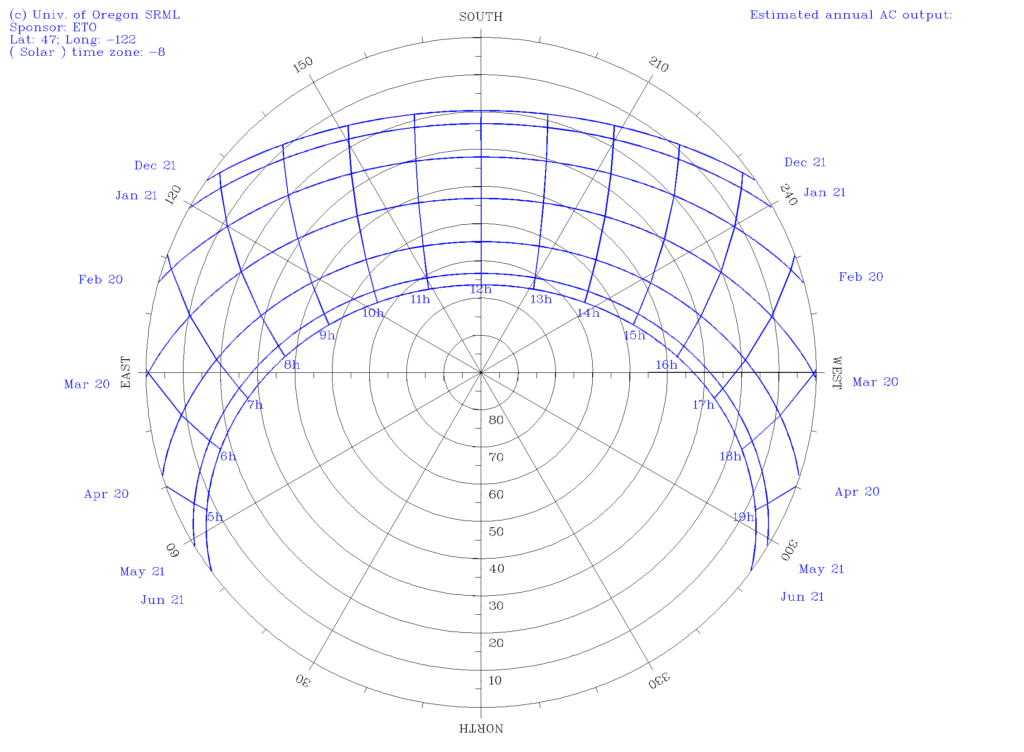Radiometer MFR-7

The MFR-7 shadow band radiometer has a rotating strip that shades the diffuser (sensor) at precise intervals throughout the day. When the shadow band shades the diffuser only indirect radiation is measured. Indirect is all the radiation that comes from the 180 degrees of sky and clouds. When the diffuser is not shaded it measures direct plus indirect. The software calculates from this the direct, indirect and total insolation in watts per meter. This is significant because focusing collectors require direct sunlight in order to reflect beams of light to a point. Flat collectors also vary in their ability to capture indirect sunlight, or sunlight filtered through clouds.
More info: MFR-7 Multi-Filter Rotating Shadowband Radiometer
Data sets
Check this page for a complete list of all available csv files. A new file is generated every day.
Click here to download csv’s
Data visualizations
Clean Energy Institute provides a set of auto-generated, online visualizations of its data sets, to help you explore trends in the data.
Click here to see data visualizations
UW Energy Dashboard for solar panel data. (Each panel has an area of 21 m^2. You can calculate the panel efficiency using the generation data from the dashboard compared to the cumulative kwh/m which is available on the custom data visualizations at the bottom of the custom graph list Panel Efficiency= (Daily Panel Kwh(from dashboard) *100) / (21 * Cumulative kwh (from radiometer))
Radiometer History
9/25 2014 First data collected- direct is measurement is not operational, total should be accurate. A shadow was being cast at about 11am by the shadowband which was coming into a rest at that position.
3/4/2015 Realigned the shadow band. Direct measurement being made correctly. The shadow band device was mounted 180 off on the shaft until this point.
6/16/2015 Noticed a cyclic jitter in the direct and indirect. We went to the device and notices a sliver of sun was hitting sensor when it should have been shaded. Adjusted it slightly on the shaft so that it was completely shaded.
11/5/2016 – Feb 9 2016- No recording due to equipment failure. For this range we have substituted data from an UW Atmospheric Sciences Pyranometer that is available through the University of Oregon Solar Radiation Monitoring Laboratory. The two sets agree on the minute by minute changes however the replacement data is variable and has an average 30% higher readings. During this period no spectral or diffuse data is available.
1/08/2017 – 1/18/2017- No recording due to power failure. For this range we have substituted data from an UW Atmospheric Sciences Pyranometer that is available through the University of Oregon Solar Radiation Monitoring Laboratory. The two sets agree on the minute by minute changes however the replacement data is variable and has an average 30% higher readings. During this period no spectral or diffuse data is available.
2/6/18 – 6/7/18 – The device was down due to a computer failure. Data was retrieved from 2/6/18- 4/15/18 and from 5/23/18- 6/7/18. Data is missing from 4/15 to 5/23. We have retrieved replacement 5 minute interval data from the U of Oregon for this period. Day2018_04 Day2018_05
9/21/10- 9/24/19 We had intermittent hardware issues. Data was reconstructed with U of Oregon data for this period.
360 degree view from the roof
This photo was taken directly north of the radiometer platform shown behind the S symbol. The uneven horizon may help explain sudden drops in the data at certain times of the year. Notice that the at our latitude on the summer solstice the sun rises about 35 degrees north of east, and on winter solstice it rises 35 degrees south of east.
Download a sunpath diagram for your latitude from the University of Oregon Solar Research Monitoring Laboratory
Data sheet for MFR-7 radiometer
CSV files have the following fields:
| date | Month/Day/Year |
| time | Seasonally corrected Pacific Standard or Daylight Time |
| serialtime | Shown in the form (days since 1900).(Fraction of a 24 hour day) in UTC time |
| cos | Cosine of the solar zenith angle (90 the elevation), cos(90 = 0), cos(0)=1 |
| temp(°C) | Temperature of collector |
| HTRV(V) | |
| tot(W/m^2) | Total of all radiation including direct and indirect (diffuse) in watts per square meter |
| tot414((W/m^2)/nm) | Total watts per square meter measured at 414nm wavelength |
| tot496((W/m^2)/nm) | Total watts per square meter measured at 496nm wavelength |
| tot613((W/m^2)/nm) | Total watts per square meter measured at 613nm wavelength |
| tot670((W/m^2)/nm) | Total watts per square meter measured at 670nm wavelength |
| tot869((W/m^2)/nm) | Total watts per square meter measured at 869nm wavelength |
| tot937((W/m^2)/nm) | Total watts per square meter measured at 937nm wavelength |
| diffuse(W/m^2) | Total of all diffuse radiation including clouds and blue sky, having direct sunlight removed, in watts per square meter |
| diffuse414((W/m^2)/nm) | Diffuse watts per square meter measured at 414nm wavelength |
| diffuse496((W/m^2)/nm) | Diffuse watts per square meter measured at 496nm wavelength |
| diffuse613((W/m^2)/nm) | Diffuse watts per square meter measured at 613nm wavelength |
| diffuse670((W/m^2)/nm) | Diffuse watts per square meter measured at 670nm wavelength |
| diffuse869((W/m^2)/nm) | Diffuse watts per square meter measured at 869nm wavelength |
| diffuse937((W/m^2)/nm) | Diffuse watts per square meter measured at 937nm wavelength |
| dirnorm(W/m^2) | total of all direct normal radiation including having diffuse light removed, in watts per square meter, adjusted assuming a flat surface oriented perpendicular to the sun rays. |
| dirnorm414((W/m^2)/nm) | Direct watts per square meter measured at 414nm wavelength |
| dirnorm496((W/m^2)/nm) | Direct watts per square meter measured at 496nm wavelength |
| dirnorm613((W/m^2)/nm) | Direct watts per square meter measured at 613nm wavelength |
| dirnorm670((W/m^2)/nm) | Direct watts per square meter measured at 670nm wavelength |
| dirnorm869((W/m^2)/nm) | Direct watts per square meter measured at 869nm wavelength |
| dirnorm937((W/m^2)/nm) | Direct watts per square meter measured at 937nm wavelength |
© 2015 Clean Energy Institute





